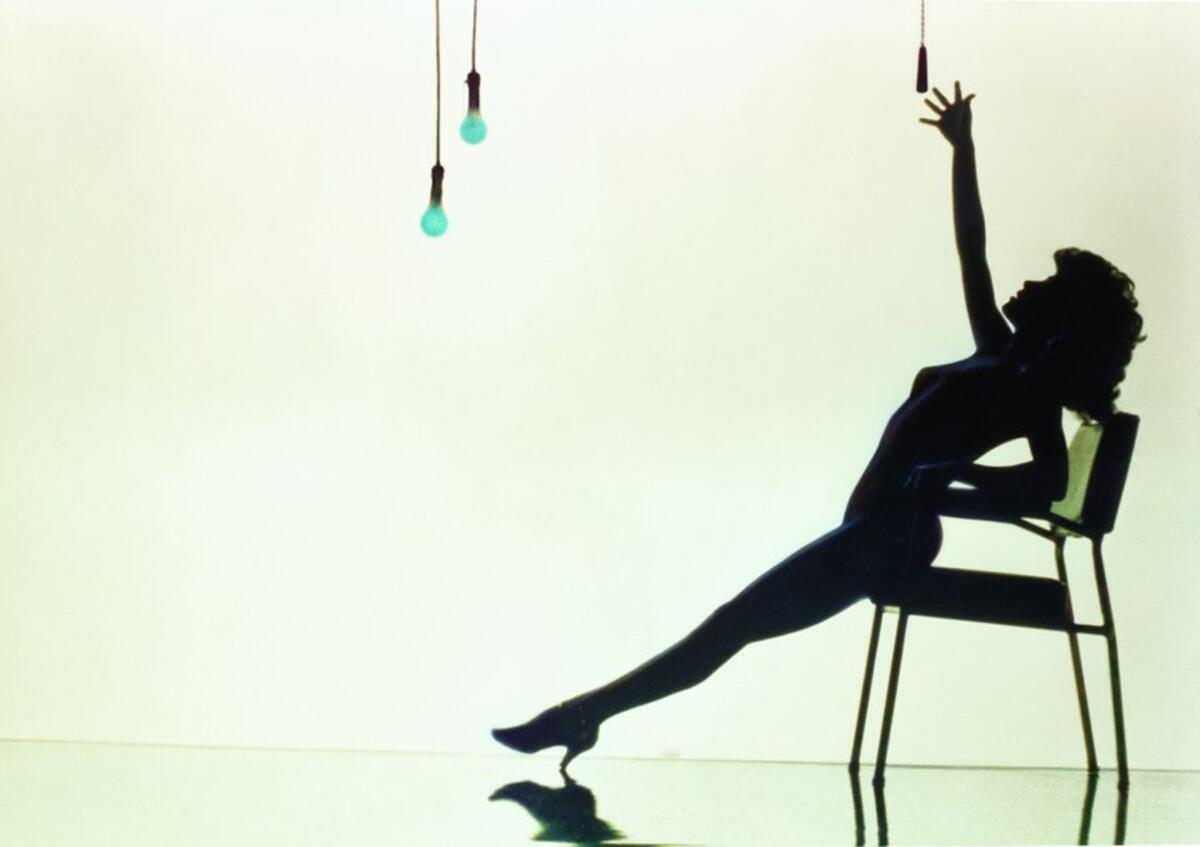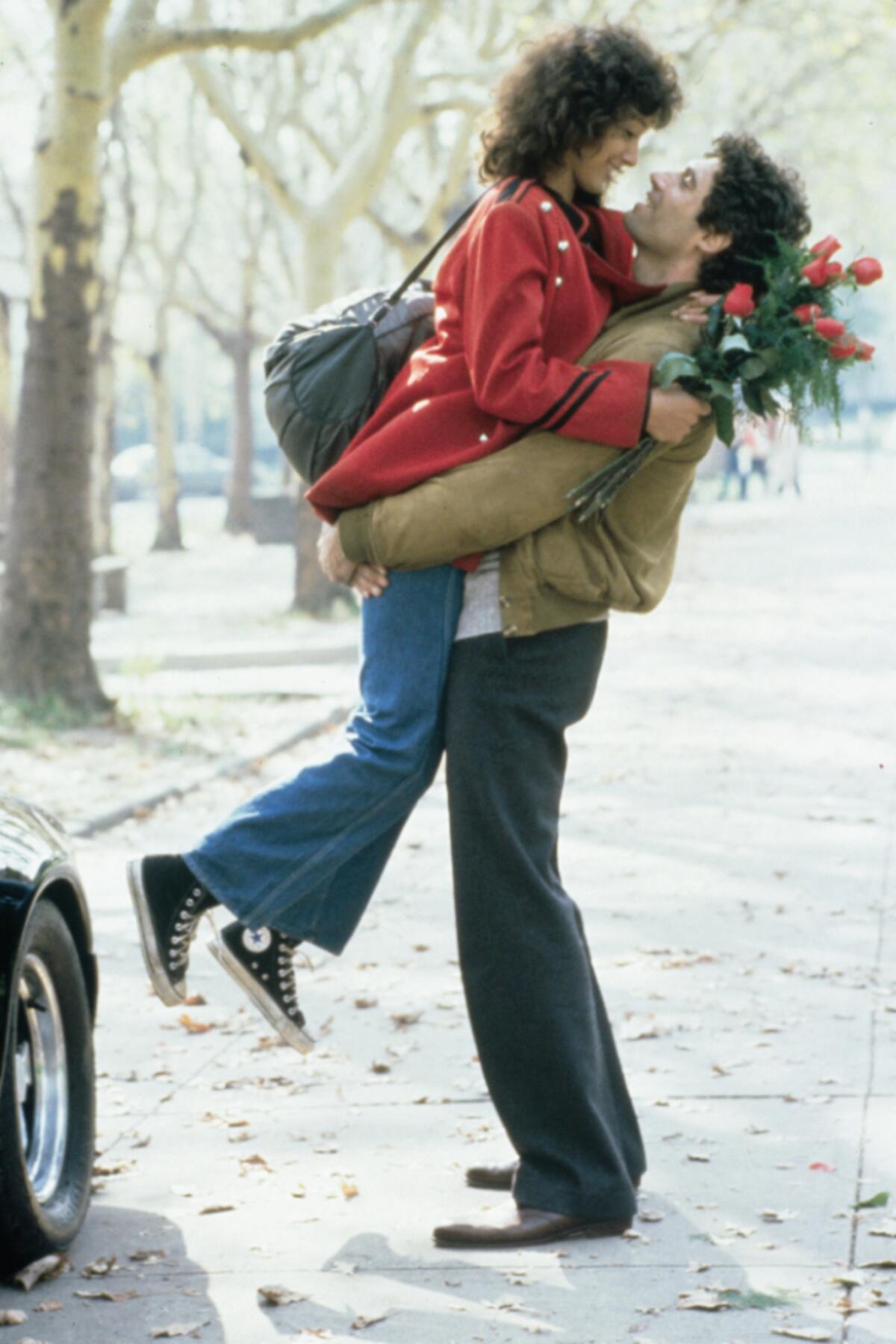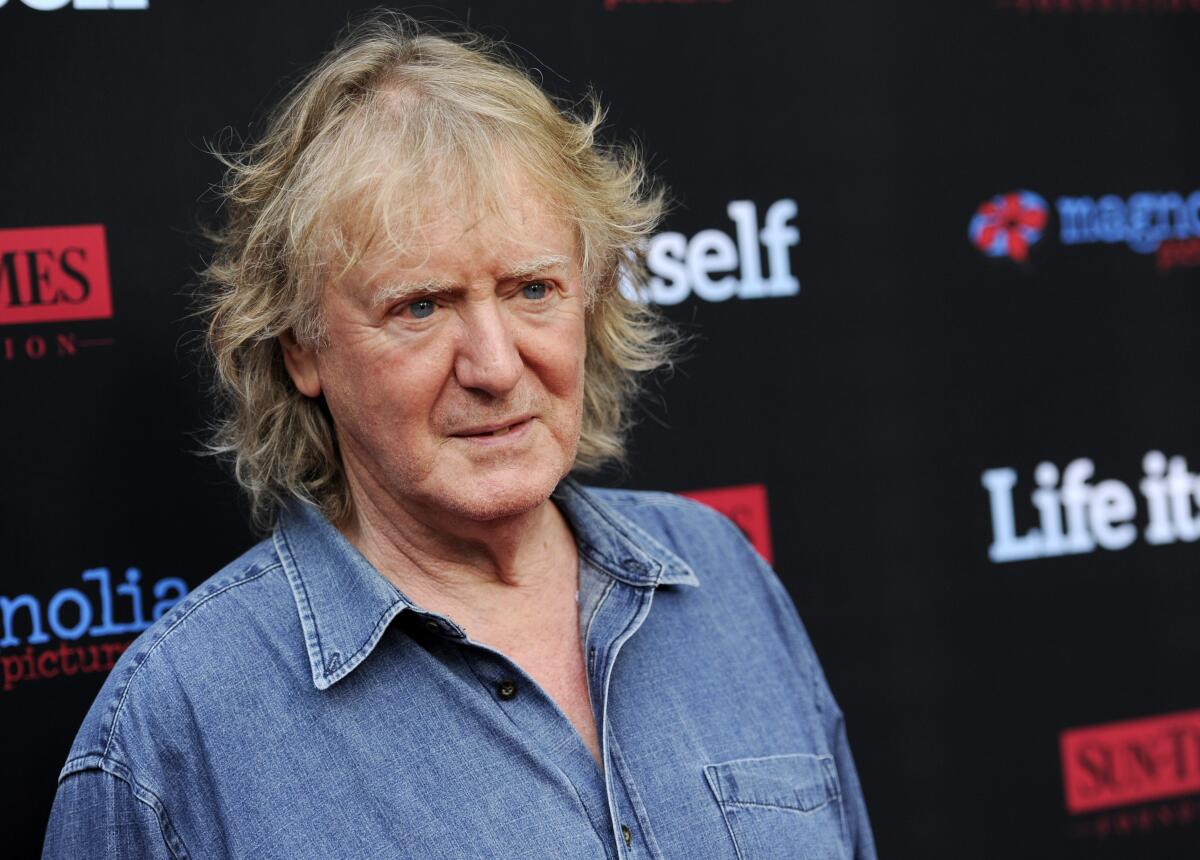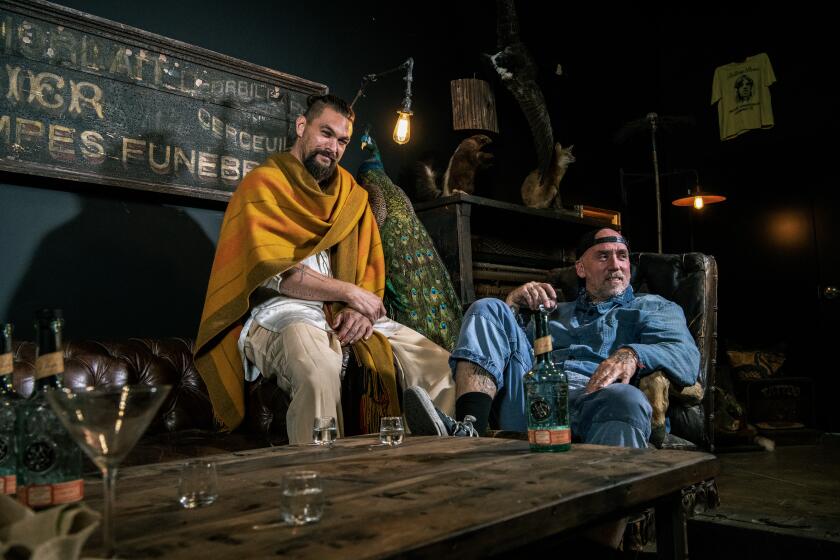‘Flashdance’ at 40: Adrian Lyne’s films are in again. Just don’t call them ‘erotic thrillers’

- Share via
“Flashdance” was one of those lightning-in-a-bottle movies that somehow perfectly captured its moment. Directed by Adrian Lyne, the movie’s atmospheric, neon-saturated style, brisk pacing, infectious music, dynamic dancing and a star-making performance by Jennifer Beals — whose off-the-shoulder sweatshirt became an immediate fashion sensation — all helped to define the early 1980s.
From the first dance number, in which Beals’ character douses herself with water onstage, the film captured audiences’ attention, as did the charged moments when Beals removed her bra from underneath her shirt or took off a suit jacket in a restaurant to reveal only a dickey and cuffs underneath. And it all turned “Flashdance” into a surprise hit. It became 1983’s No. 3 movie at the domestic box office, sold nearly 20 million copies of its Grammy-winning soundtrack album and earned four Academy Award nominations, winning original song for the eternally catchy “Flashdance… What A Feeling,” written by Giorgio Moroder, Keith Forsey and Irene Cara.
The movie was the first starring role for Beals, who was a 19-year-old freshman at Yale when the movie was released. In the film she plays Alex, a young woman who works as a Pittsburgh welder by day while dancing in a cabaret at night, with dreams of formally studying ballet. She gets into a romantic relationship with her boss Nick (Michael Nouri), but their differences in age and class present numerous hurdles to their happiness. The movie had quite a lineup behind the scenes too, with a script co-written by a relatively unknown Joe Eszterhas and producer credits for Jerry Bruckheimer and Don Simpson (in their first collaboration) and Lynda Obst.
We went drinking with Jason Momoa, co-creator of Meili Vodka, to understand why actors, musicians, athletes and more want in on the liquor business.
As for Lyne, who started his career in advertising in England and made his feature directing debut with 1980’s “Foxes,” “Flashdance” kicked off a fruitful period: He then directed “9 ½ Weeks” and “Fatal Attraction,” which nabbed six Oscar nominations, including best picture and director for Lyne. His other films include “Jacob’s Ladder,” “Indecent Proposal,” “Lolita,” “Unfaithful” and 2022’s “Deep Water.”
April 15 marks the 40th anniversary of “Flashdance‘s” release, and Paramount, which has just released a new 4K disc of the film, will hold select theatrical screenings around the country later in the month. And although Lyne says he’s “a little bit wary” of the upcoming TV series adaptation of “Fatal Attraction,” the longevity of his work is meaningful to the filmmaker, now 82. In particular, the reappraisal of his films’ stylization and eroticism — though he prefers not to think of them as “erotic thrillers” — is heartening given the critical drubbing they often received in their time.
As Lyne noted, “I’ve never been the critics darling. Especially in the L.A. Times.”

You’ve been open in the past that you didn’t think much of the script when you first read it and initially turned the project down. So what was in that script that was still of interest to you?
The dances, mainly. I thought maybe I could give it some energy. And also it made a big difference when I saw Jennifer Beals. I looked at the movie yesterday. I hadn’t seen it in 15 years or something. And I thought she was good. She had a vulnerability that made it work and made it less absurd. In the end it’s just a fairy story, really. I mean, I don’t think people should take movies so seriously. Sometimes you should not be so painstakingly logical with everything. Of course, it was absurd, a welder wanting to be a ballet dancer. But in the end, why not?
In your mind, were you making a musical and did you see those dance numbers as a way to leave reality? Like it didn’t have to totally make sense what was happening onscreen during those dance numbers?
Exactly. It was sort of a little stylized, and it is a musical in its way. And people said, “Oh, it’s a lot of MTV stuff all bundled up or whatever.” And MTV hadn’t started then. I mean, MTV literally started when the movie came out. It was all over MTV. [MTV launched in August 1981 but was not immediately available in all markets.]
If anything, it’s the other way around. This movie in particular was so influential on what MTV would look like.
Yes, I think that’s sort of true. But it’s good. People said, “Have you seen everybody’s wearing that shirt that hangs off her shoulder?” And I went out into the street and they were. It’s funny, I remember watching an early-ish preview with my assistant and there were executives from Paramount in the back. So it was a little unnerving. And I was watching the film, and I leaned over and whispered to my assistant, “Is this as bad as I think it is?” And there was a long pause and then he said, “Yes.” And then I said to him, “Is there any way we can get out of the theater without them seeing at the back, without the executives seeing?” And as I said that, people started laughing at something in the film, and I could tell that they actually quite liked it. It’s strange, you get into such a state of anxiety and depression, at least I do, and you can’t see the wood for the trees.
I’ve always thought my job really is more a selector than a director. You’re selecting everything — locations, casting, ideas, whatever.

Some of the visual ideas in the movie — all the sparks at the factory, the way that you often shoot people backlit in smoke — how conscious were you of those as a real visual signature?
Well, I guess I knew that the story was thin. And I just wanted to make it look good. And I sort of chose a stylized route, obviously. It’s absurd the way that building site looked, with all the welding stuff. So that was just a flight of fancy. As I say, I think people take movies a little bit too seriously sometimes. It’s just a choice.
For a lot of people, one of the first and best ways to see breakdancing was in “Flashdance” during a brief moment where Jennifer Beals and her friend stop and watch some breakdancers on the street. How did you come to that?
There was a club in New York called the Roxy and gangs from the Bronx would dance there, breakdance as rival gangs. And I was just blown away. I couldn’t believe having seen this. And so I put this little sequence together where they’re watching them. And I showed the film to Michael Eisner [then president of Paramount], I’m not sure I should be saying this, but he said, “What’s that in there? What’s that? That doesn’t push the story forward.” He said, “Take it out.” And I had no clout at that stage at all. I said, “Please, please let me have a minute. Just let me have a minute of it.” I said, “It’s unbelievable, look at it.” And he let me. He was a sweet man, actually. And so I kept a minute of it in, and people couldn’t believe it, seeing that for the first time. People were just stunned.

At the time the movie was really criticized for being smutty, like it was too sexy of a movie. But there is hardly any nudity. There’s only one very discreet love scene. The movie does have this pervasive air of sexiness or sensuality about it somehow. Does it feel that way to you?
I think people are very weird. There’s a scene where she’s working out and the dog’s there — it’s funny because it’s pre-pit bulls. Nobody knew what a pit bull was then. Nobody knew to be frightened of this dog. But I remember how great her legs looked and her thighs specifically. And people said, “How could you concentrate on her thighs like that?” As if there’s something inherently wrong or disgusting. I was thinking about it the other day, in America for some reason, when talking about sex they always say “smutty.” Smutty or something derogatory, like there’s something inherently wrong about sex or f— or whatever. And it seems just so nuts. You can see a movie when they blast people into pieces and shoot their heads off and nobody gives a f—. That they will watch till the cows come home. But you get stick if you put the camera on a girl’s thighs while she’s dancing. And I had so many people say over and over there is too much emphasis on it. Silly, isn’t it?
Do you feel like that was something you then took forward to ”9 ½ Weeks” and “Fatal Attraction” and “Indecent Proposal,” this air of eroticism and sexiness? That’s something that you in particular had a real feel for.
I hope I do. I’ve always wanted to do relationship pieces and sex is part of that. Especially if it’s about an affair with Glenn Close [in “Fatal Attraction”]. Then you decide, “Where am I going to go? How am I going to do it? Shall I do it in bed where everybody else does it? Or shall I make it sort of fun and do it over the sink and then he can’t get his pants off and hopefully get a laugh out of that?” But I don’t like this sort of blanket thing of “erotic thriller.” I think it’s meaningless.
I hope that “Fatal Attraction” was some sort of a thriller. And there was two minutes maximum of sex in the movie. Two minutes out of two hours. I’m not beating them to death with it all through the movie. It’s just that the moments of the sex tend to be what people remember. It floats to the top. Which is weird. I mean, I suppose people are into it and why shouldn’t they be interested in sex? [Laughs.] But there’s two scenes, one over a sink and one in an elevator, and that’s all. If I was doing “9 ½ Weeks” now, I would do it in a much grittier way. I chose to do it in a stylized way, with too much of an insistence on the look. And I don’t think I did “Fatal Attraction” that way, really. I mean, it’s not documentary-ish, but I don’t think there was an insistence on the visual.
In “Deep Water,” there’s a line that Ben Affleck has where their young daughter asks why Ana de Armas’ character had done something. And he says, “Because people are strange and grown-ups are complex.” Which in some ways sounds like a throughline to all your movies. If there’s a theme that connects your films, I think that’s it.
I’ll settle for that. Absolutely. I always like the small picture, I’ve always liked making a movie about you and me or you and your wife. I’m not interested in doing vistas. I like making things look nice, but “The Matrix” I wouldn’t want to make. I love the small picture.
More to Read
Only good movies
Get the Indie Focus newsletter, Mark Olsen's weekly guide to the world of cinema.
You may occasionally receive promotional content from the Los Angeles Times.












